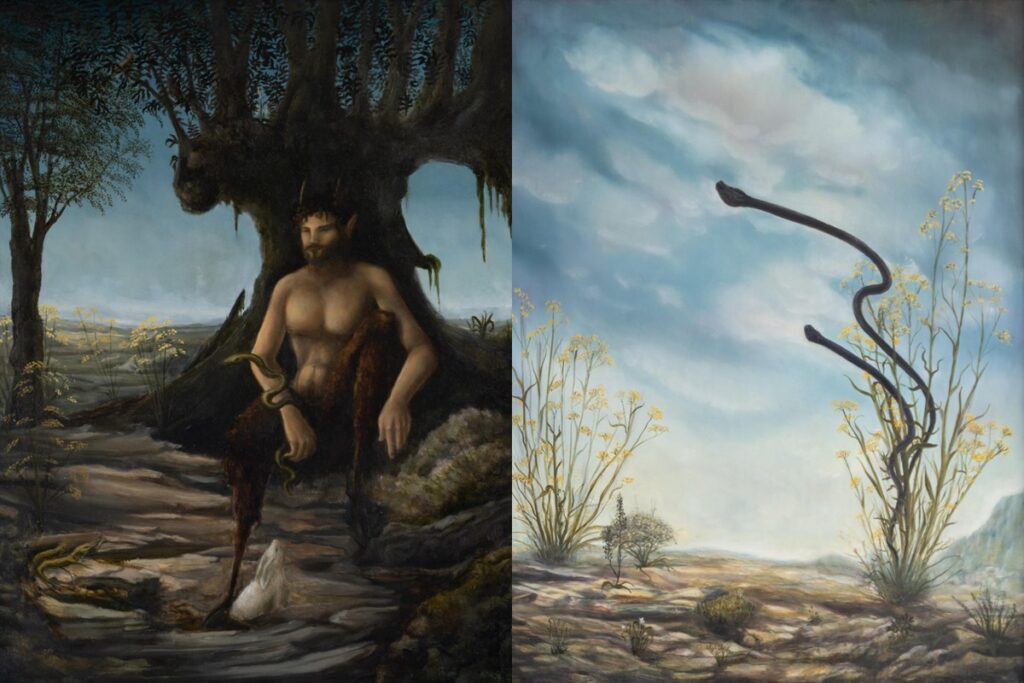Hedymeles presents a body of work that merges philosophical inquiry with Renaissance-inspired technique. The paintings are grounded in a short novel Attard authored, on show in the exhibition as a hand-bound volume available for visitors to read.
“Hedymeles is written as a fairytale for adults with motifs from classical Greek mythology,” says Attard. “It is a journey of self-discovery that the main character is somewhat forced to make. Through this journey (and transformation), the prejudices and frameworks that socialised people have regarding the landscape they live in become alien to him and as a result, the fantastical becomes indistinguishable from the ordinary, or rather, the ordinary becomes in itself extraordinary for Hedymeles.”
“The story asks us to think about what is more important; whether to primarily recognize ourselves as animals who participate in a context (or ecosystem) or as superior beings who have allowed ourselves to use up whatever resources we might want. Which of these two points of view allow for the most freedom and moral judgement today?”
“Mythologies serve a primal human function in any group. Story telling is at the heart of how culture comes about and mythology allows us to ponder and hypothesize bigger and more intangible questions. If the players on our stage are only half human, then, their actions are perhaps a little freer from consequence or morality and therefore, we can play out our comedies and tragedies without having to feel too awful or cruel sometimes.”
“In painting, these creatures become the embodiment of part of what the human spirit can be. They might help express a more primal rage or sexuality. They might help remind us of our childhood where excitement was unfettered. During the Renaissance these themes were explored in a joyful manner. The dedication it took to complete such works, which were sometimes meant to be funny or purely decorative, serve as a reminder that wonder and fantasy deserve a platform. These works can be seen as the result of a sort of meditation on the matter. It could be an escape for the painter to go to escape their reality for some time. It could serve as a reminder to view aspects of life differently and organize one’s view of the world. Personally, I think that I am attracted to these periods in art because artists and artisans took their time. Slowness and patience were honed as much as their other skills. All the steps necessary in the craft are given their due consideration so by the end of the project, the final pieces are actually saying something. There is depth. I truly appreciate that as a viewer and strive towards it as an artist.”
“And so Attard’s paintings are not mere illustrations; they stand as autonomous works that extend the novel’s mythic and post-human themes into the visual realm, weaving narratives where beauty, cruelty, and desire converge,” says curator Melanie Erixon.
“The paintings are displayed in the order of the narrative; however, viewers are free to either speculate what the paintings are trying to illustrate or take in each piece individually as a stand-alone work. They are each left a little open so that the viewer has a say in the allegory. I would like the individual’s self-mythos to influence the interpretation,” adds Attard. “For those who tend more on the curious side, they can peek at the story itself and piece things together.”
Attard’s practice resists the accelerated pace of contemporary image culture. Each work unfolds through a slow, layered process rooted in Renaissance methods. Drawing on the legacy of Leonardo and Michelangelo, light builds from beneath, and the narrative emerges within an otherworldly luminosity. Built through as many as twenty layers of paint, these surfaces achieve remarkable depth and radiance. The result is a magical realism that fuses classical sensibilities with fantastical invention.
The imagery oscillates between the grotesque and the sensual: menacing harpies, a wise, talking caper bush, and hybrid beings charged with violence and eroticism. These figures channel Attard’s engagement with mythology as a lens through which to explore post-human existence and the rejection of societal constraints. By situating myth in dialogue with contemporary excess and disillusionment, Hedymeles reclaims the act of painting as both narrative and resistance — resistance to speed, to digital consumption, and to the one-minute spectacle.
